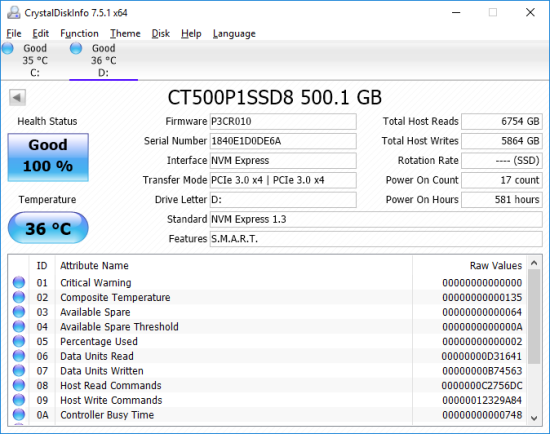TRIM Performance:
While SSD's offer many benefits, there are some downsides to using flash memory. One of the biggest issues people run into is performance degradation. Over time, an SSD will run out of fresh blocks and will have to write over data the file system has marked as deleted. This procedure is very complicated and can slow an SSD's write speeds considerably.
To fix this problem, most manufacturers have added TRIM support to their SSDs. The TRIM command allows an operating system, such as Windows 7, to tell an SSD which data blocks are no longer in use. Using this information, the drive pro-actively erases these blocks and adds them to the free block pool.

To test the P1's TRIM and garbage collection functions, I first put the drive in a "dirty" state. I used Iometer to fill 80% of the drive and then ran a random write test for 30 minutes. This had little impact on the P1's read speed. However, its average writing speed dropped to 45.49 MB/s.

Crucial P1 - Dirty
To see how well the P1 could recover, I let the computer sit for about 30 minutes and then reran the test. The drive wasn't able to reach the factory fresh performance shown in our earlier tests. However, its sequential write speed jumped up to 843.81 MB/s.

Crucial P1 - After TRIM
Lastly, I used Parted Magic to perform a secure erase on the P1. With the drive wiped clean, it had average read and write speeds of 1757.94 MB/s and 899.97 MB/s, respectively.

Crucial P1 - Secure Erased
Final Thoughts:
While not the fastest or most feature packed PCIe SSD to come through the 'Labs, the Crucial P1 offers a lot of bang for your buck. This compact, M.2 form factor SSD is powered by Silicon Motion's SM2263EN controller and is available with up to 2TB of Micron's 3D QLC NAND flash. Combine this with a PCIe Gen3 x4 NVMe 1.3 interface and you have an affordable, high capacity drive capable of delivering performance well beyond that of your average SATA 6Gb/s SSD. In our sequential read and write tests, the 500GB version of the P1 was able to read at speeds as high as 1,931 MB/s and write at speeds in excess of 927 MB/s. The drive also did relatively well in our random write tests, producing more than 142,000 IOPS at low queue depths.
Of course, fast read and write speeds aren't the only things the P1 has to offer. In addition to a large DRAM cache buffer, the drive uses hybrid-dynamic write acceleration to help boost write performance. The P1 also features power loss protection for data-at-rest, static and dynamic wear leveling and TRIM support. To top it all off, it comes with Acronis True Image cloning software and is covered by a generous 5 year warranty.
The Crucial P1 is available now in 500GB and 1TB capacities. Prices on Amazon.com start at $90 for the 500GB drive reviewed here and go up to $170 for the 1TB version. The 2TB model has not shipped yet but is expected to hit retailers some time in the near future.

Highs:
- Available in 500GB, 1TB and 2TB capacities
- PCIe 3.0 x4 interface with NVMe protocol
- Silicon Motion SM2263EN controller
- Equipped with Micron 3D QLC NAND
- Good sequential and random read and write performance
- Small M.2 2280 form factor
- Large DRAM cache
- Hybrid-dynamic write acceleration
- Includes Acronis True Image cloning software
- Reasonably priced
- 5 year warranty
Lows:
- Write speed drops when SLC cache is full
- Does not support hardware based encryption

